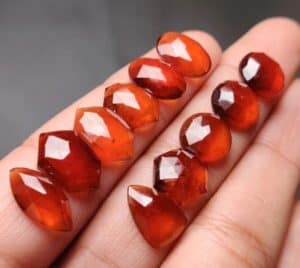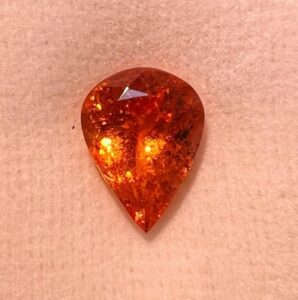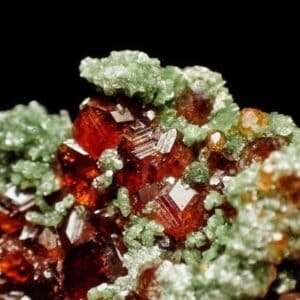Hessonite garnet is a variety of grossular garnets with colors ranging from golden yellow to brownish-red or brownish-orange and reddish-orange to red. The first Sri Lankan stones discovered were nicknamed “cinnamon stones” because of their brownish-red color.
A perfectly colored hessonite stone with be bright orange and have a high clarity rating. Most stones will come with inclusions and it is acceptable to have high-quality stones with SI1-SI2 clarity ratings.
How to Identify Hessonite Garnet Through Testing
There are various ways to identify rocks, minerals, crystals, and gemstones, but we will be using a method I learned while attending the Gemological Institute of America. If you’ve learned a unique way to identify gems, then feel free to share it with us.
Let’s take a deeper look into how to identify hessonite garnet like a pro.

Visual Inspection
The visual inspection starts with what form of hessonite garnet you have. The questions below are relatively easy to answer, but each type will have its own process for identifying them.

Is it a cabochon? If you’re dealing with a cabochon, then it should have a medium to high polish with very little pitting on the surface. The colors range from bright to dark red. If the bottom isn’t polished, it may appear a blood-red color. You’ll want to use a 10x loop if you have one because it will help with identifying natural inclusions.

Is it faceted? If you have a faceted piece of hessonite garnet, it should be transparent and you’ll see inclusions via your naked eye. These inclusions have been given a specific name, sugaring or sugar crystals. When you view them through a 10x loop or microscope you’ll notice the included crystals look like sugar crystals.
Hessonites sometimes display a visual effect resembling roiled or disturbed water within the stones. The roiled appearance is also referred to as “whisky in water” and a “heat wave” effect. While a similar result can occur in other stones, the appearance in garnets can be an identification marker, helping to confirm the stone is hessonite.
That said, more recent discoveries of hessonites tend to lack the roiled effect, including specimens from Orissa, India, and Afghanistan. This means that the absence of a roiled effect cannot rule out potential hessonite, which is why several tests exist.

Is it a specimen? Hessonite Garnet is found in different forms. You’ll get better at identifying these forms by looking at and inspecting them over time. Here’s a list of characteristics Hessonite Garnet displays when it’s a specimen.
- Chocolaty brown, burnt orange to orange exterior coating with brownish-red undertones.
- You’ll be able to do the streak test. Keep reading below if you have a rough piece with no commercial value.
- A sparkling effect on the outside surface. This will look like a rainbow of orange colors, almost like a thin coating.
- It can be found in crystal form, but it’s rarer, and you’re not likely to come across it very often. These crystals are typically on the smaller side and considered to be micro-specimens.
Is it tumbled? If you do come across tumbled hessonite garnet then it might be in a bead shape. Over the past couple of years, beaded bracelets have become quite popular and hessonite beads have flooded the market. The colors range from brown and deep orange to more of a bright orange with hints of golden brown and white.
Physical Properties of Hessonite Garnet
Let’s take a look at the physical properties of hessonite garnet. Knowing what to look for will help you more easily identify what you’re looking at.
Color: Yellow, Orange, Red, Brown, Brownish-Red, Brownish-Orange, Reddish Orange
Clarity / Transparency: Transparent – Semitransparent
Luster: Vitreous, Greasy
Cleavage: None
Fracture: Irregular/Uneven, Conchoidal
The Streak Test
This is a destructive test, so you need to ensure that you’re allowed to damage the specimen or stone if you choose to use this method. Once you’ve developed robust knowledge in identifying rocks and minerals, you won’t use destructive tests.
A mineral streak test involves scraping the stone against a harder surface to see what color remains. When dealing with Hessonite Garnet, the streak can be white or colorless.
Tumbled specimens are tested by scraping a specimen across a piece of ungalvanized porcelain, typically known as a streak plate.
Magnet Test
Hessonite garnet is among the least magnetic of Garnets due to the lower iron levels, so it shouldn’t respond to common magnets.
Hardness Test
I don’t recommend actively testing the hardness of a stone because it’s destructive in nature and doesn’t really provide a definite answer to what type of stone it is. That said, Hessonite Garnet has a hardness of 6.5 to 7.5 on the Mohs hardness scale.
Refractive Index Test
Determining the refractive index, or RI as it’s referred to by gemologists, for Hessonite Garnet is reasonably straightforward, but you’ll need a specific piece of test equipment and the RI fluid to go with it. Before you place the stone on the refractometer, you want to make sure you have a flat, somewhat polished surface to take a reading.
Hessonite Garnet’s Refractive Index: 1.730 – 1.758
Each gemstone has its own RI, so discovering a sample’s RI can help you figure out what sort of stone it actually is.
Step 1 – Place a small bead of RI fluid on the metal surface of the refractometer near the back of the crystal hemicylinder (the window on which the stone will sit).
Step 2 – Place the stone facet face down on the fluid dot and slide it toward the middle of the hemicylinder crystal using your fingers.
Step 3 – Look through the viewer lens without magnification. Continue looking until you see the outline of a bubble, then look at the bottom of this bubble. Take the reading from there, rounding the decimal to the nearest hundredth.
From time to time, you’ll run into the issue of not having a flat surface to work with. In this instance, you’ll need to leave the top of the refractometer open and hold the rounded stone with your hand. Hopefully, you’ll be able to pull a reading off the gauge.
Birefringence Test
You won’t be using this test for hessonite garnet, but I wanted to include this test just in case you were considering it in your process.
Consider testing the birefringence, as well. Birefringence is related to RI. While doing the birefringence test, you will turn the gemstone on the refractometer six times throughout the observation period and note the changes.
Perform a standard RI test. Instead of keeping the stone still, gradually turn it 180 degrees, making each separate turn about 30 degrees. At each 30-degree mark, take a new RI reading.
Subtract the lowest reading from the highest to find the stone’s birefringence. Round it to the nearest thousandth.
Birefringence: 0.0 – 0.005
Single or Double Refraction
Hessonite is singly refractive, meaning it will only have one refractive index.
You won’t be using this test for Hessonite Garnet, but I wanted to include this test just in case you were considering it in your process. For this test to be accurate and beneficial, the stone needs to be transparent in nature. If the light won’t pass through the stone, then there is no way to test for single or double refraction.
Check for single or double refraction. Use this test on translucent and transparent stones. You can determine whether the stone is only singly refractive (SR) or doubly refractive (DR) to help identify it. Some stones can also be classified as aggregate (AGG).
Turn on the light of a polariscope and place the stone face down on the lower glass lens (polarizer). Look through the top lens (analyzer), turning the top lens until the area around the stone looks darkest. This is your starting point.
Turn the analyzer 360 degrees and watch how the light around the stone changes.
If the stone appears dark and stays dark, it is likely an SR. If the stone starts light and remains light, it is likely AGG. If the stone’s lightness or darkness changes, DR is likely.
Checking The Diaphaneity
Diaphaneity refers to the mineral’s ability to transmit light. For instance, some minerals are transparent or translucent. A small amount of distortion might occur when they’re thick, but light will pass through them relatively freely.
Hessonite garnet is transparent to translucent. However, its translucency depends on the form it has taken. If the Hessonite Garnet has an earthy form, there won’t be much light traveling through it. Still, if it happens to take on a crystalline structure, you should expect an opaque diaphaneity.
Finding The Specific Gravity
Every stone has its unique specific gravity, which helps us identify them. Specific gravity is one of the best properties to measure when identifying mineral specimens. Most minerals have a narrow range of specific gravity, so getting an accurate measurement can go a long way toward identification.
Specific gravity is a unitless number describing how heavy a mineral is compared to equal volumes of water. For example, if a mineral is three times as dense as water, it’ll have a specific gravity of three. This is useful because while two minerals might be the same size, they’ll each have a different specific gravity.
The larger the sample, the more precise the readings tend to be. Remember that this technique can only be used for single mineral or crystal masses. It will not work for minerals embedded in host rocks.
Hessonite Garnet’s Specific Gravity: 3.570 – 3.730
As helpful as specific gravity is for identifying minerals, amateurs are usually constrained by the lack of necessary tools for the job. However, one way to work around this is to hold the specimen and note how heavy or heft it feels compared to what you might expect a specimen of that size to weigh.
If you want to determine the specific gravity of your stone like a pro, then you’ll need to invest in a higher-end scale. This is the one gemologists use OHAUS Density Determination Kit.
Identifying Rocks and Minerals Like a Pro
Hopefully, you feel confident in your practice to identify a piece of hessonite garnet after reading and applying this guide. You’ll be using the visual part of this guide the most, and you’ll get better as you interact with more gemstones. Before you know it, you’ll be identifying stones like a gemologist.
If you run into any issues or get confused, then feel free to reach out, and I’ll do my best to assist you in the identification process.
- Identify Enstatite - March 12, 2024
- Identify Cerussite - March 3, 2024
- Identify Bytownite - February 18, 2024
